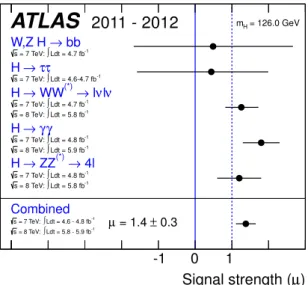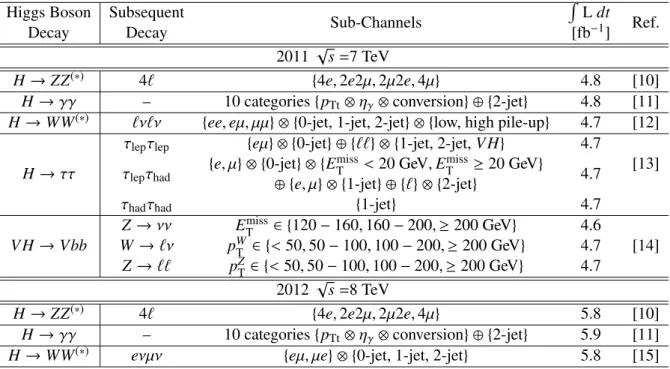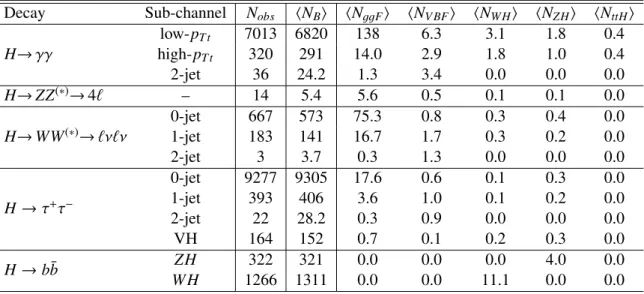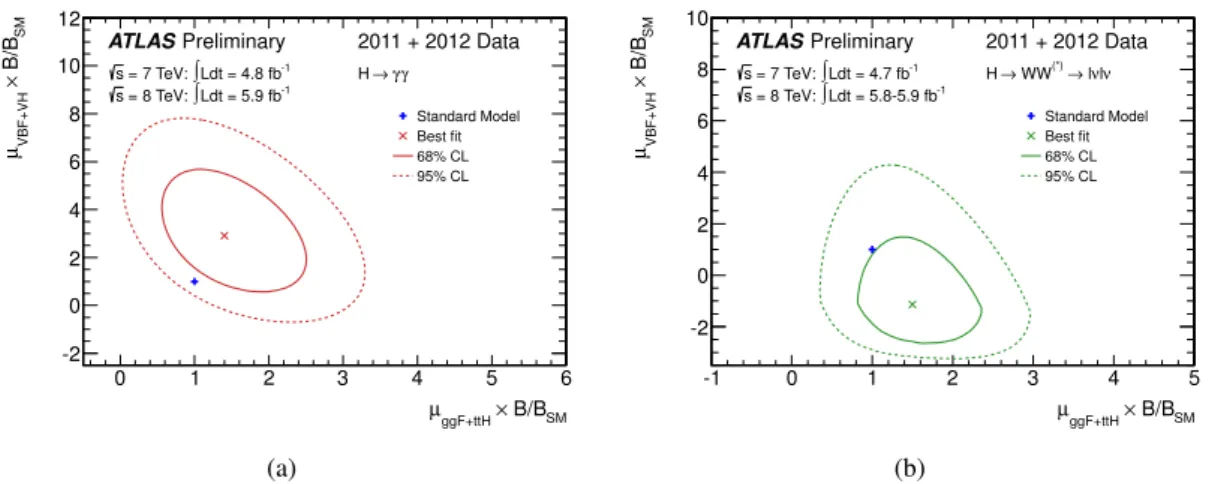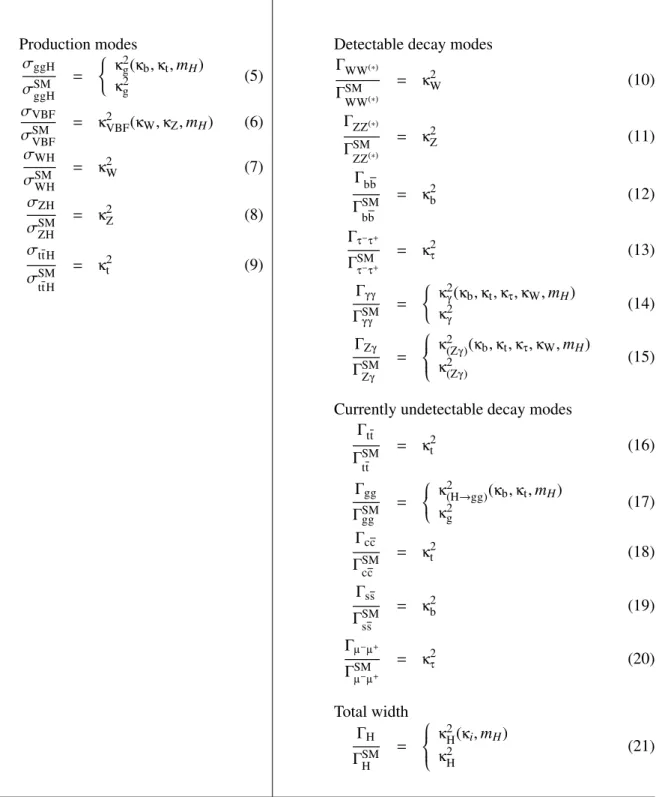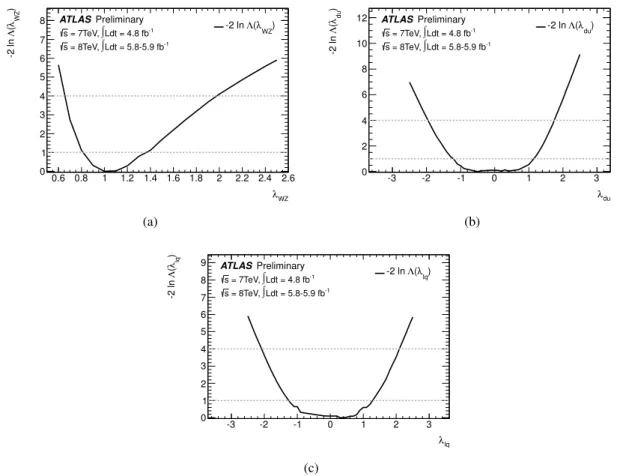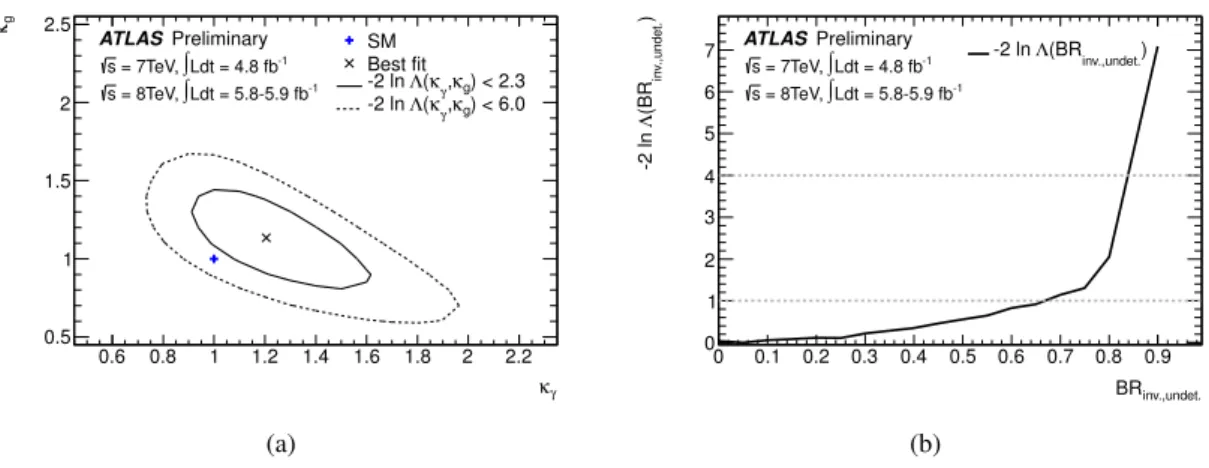ATLAS-CONF-2012-127 10/09/2012
ATLAS NOTE
ATLAS-CONF-2012-127
September 10, 2012
Coupling properties of the new Higgs-like boson observed with the ATLAS detector at the LHC
The ATLAS Collaboration
Abstract
Details of the production and decay of the new particle discovered in the mass region of 126 GeV in the search for the Standard Model Higgs boson at
√s=
7 TeV and
√s=
8 TeV are presented. The searches in the
H→ZZ(∗)→4ℓ,
H→γγ, H→WW(∗)→ℓνℓν, H→τ+τ−and
H → bb¯ channels include several exclusive final states, which provide sensitivity to the coupling properties of the observed particle through the various production and decay modes. Several benchmarks are considered that are designed to probe different aspects of the SM Higgs boson couplings. No significant deviation from the prediction for a SM Higgs boson is found.
c Copyright 2012 CERN for the benefit of the ATLAS Collaboration.
Reproduction of this article or parts of it is allowed as specified in the CC-BY-3.0 license.
1 Introduction
The observation of a new particle in the search for the Standard Model (SM) Higgs boson at the LHC reported by the ATLAS [1] and CMS [2] collaborations, is a milestone in the quest to understand electroweak symmetry breaking. In Ref. [1] the ATLAS collaboration reported the initial estimate for the mass of the particle to be
126.0
±0.4 (stat)
±0.4 (syst) GeV
obtained from the H
→γγand H
→ZZ
(∗)→4ℓ channels. Figure 1 illustrates how this observation was made simultaneously in various SM Higgs boson search channels by showing the best fit value for the global signal strength
µfor a Higgs boson mass hypothesis of m
H=126 GeV, which scales the totalnumber of events from all combinations of production and decay modes relative to their SM values, for the individual channels and the combination. The signal strength parameter is a convenient observable to test the background-only hypothesis (µ
=0) and the SM Higgs hypothesis (µ
=1). However the detailed consistency of the production and decays of this new particle with the expectation for the SM Higgs boson still needed to be assessed.
µ) Signal strength ( -1 0 1 Combined
→ 4l ZZ(*)
→ H
γ γ
→ H
ν νl
→ l WW(*)
→ H
τ τ
→ H
→ bb W,Z H
Ldt = 4.6 - 4.8 fb-1
∫ = 7 TeV:
s
Ldt = 5.8 - 5.9 fb-1
∫ = 8 TeV:
s
Ldt = 4.8 fb-1
∫
= 7 TeV:
s
Ldt = 5.8 fb-1
∫
= 8 TeV:
s
Ldt = 4.8 fb-1
∫
= 7 TeV:
s
Ldt = 5.9 fb-1
∫
= 8 TeV:
s
Ldt = 4.7 fb-1
∫
= 7 TeV:
s
Ldt = 5.8 fb-1
∫
= 8 TeV:
s
Ldt = 4.7 fb-1
∫
= 7 TeV:
s
Ldt = 4.6-4.7 fb-1
∫
= 7 TeV:
s
= 126.0 GeV mH
± 0.3 = 1.4 µ
ATLAS
2011 - 2012Figure 1: Measurements of the signal strength parameter
µfor m
H=126 GeV for the individual channelsand their combination.
This document presents the measurements of coupling properties of the observed new particle under several benchmark scenarios. The measured observables are deviations of the couplings from those predicted for a SM Higgs boson. The observed state is assumed to be a
CP-even scalar as the Higgs boson of the SM. The results are based on the same analyses and data sets as in Ref. [1] with the same statistical model describing the experimental and theoretical systematic uncertainties. The aspects of the individual channels relevant for these measurements are summarized in Section 2. Section 3 outlines the statistical procedures used for considering multi-parameter likelihood functions. The systematic uncertainties that contribute to the measurements are listed in Section 4. Model-independent contours in terms of production cross-sections and branching ratios are presented in Section 5. Finally, the results of fits to specific benchmarks designed to probe Higgs boson couplings are presented in Section 6.
The benchmarks follow the recommendations of the LHC Higgs Cross Section Working Group [3] and
references therein, in particular the approach adopted in this note was initiated in Refs. [4, 5, 6, 7, 8, 9] .
2 Individual Channels
The different channel categories considered in this analysis are summarized in Table 1. Many of the sub-channels are introduced to enhance sensitivity to the SM Higgs boson (e.g., the categorization of events according to lepton flavor or low/high pile-up) but do not provide any discrimination between different production modes. In contrast, requirements on lepton and jet multiplicities, on low/high-p
Tt(a variable related to the transverse momentum of the Higgs boson) in the H
→γγchannel, and on E
missT(the transverse missing momentum) provide discrimination between different production modes. Table 2 summarizes the primary sources of discrimination between the different production modes and provides representative numbers of events satisfying the selection requirements from the various SM production modes for a 126 GeV Higgs boson. These numbers refer to mass windows that contain about 90% of the signal and to the combination of the luminosities and centre-of-mass energies reported in Table 1.
Table 1: Summary of the individual channels entering the combination. The transition points between separately optimized m
Hregions are indicated where applicable. In channels sensitive to associated production of the Higgs boson, V indicates a W or Z boson. The symbols
⊗and
⊕represent direct products and sums over sets of selection requirements, respectively.
Higgs Boson Subsequent
Sub-Channels
R
L dt
Decay Decay [fb
−1] Ref.
2011
√s
=7 TeVH
→ZZ
(∗)4ℓ
{4e, 2e2µ, 2µ2e, 4µ
}4.8 [10]
H
→γγ– 10 categories
{p
Tt⊗ηγ ⊗conversion
} ⊕ {2-jet
}4.8 [11]
H
→WW
(∗) ℓνℓν {ee, eµ, µµ
} ⊗ {0-jet, 1-jet, 2-jet
} ⊗ {low, high pile-up
}4.7 [12]
H
→τττlepτlep {
eµ
} ⊗ {0-jet
} ⊕ {ℓℓ} ⊗ {1-jet, 2-jet, V H
}4.7
τlepτhad {
e, µ
} ⊗ {0-jet
} ⊗ {E
Tmiss<20 GeV, E
Tmiss≥20 GeV
}4.7 [13]
⊕ {
e, µ
} ⊗ {1-jet
} ⊕ {ℓ} ⊗ {2-jet
}τhadτhad {
1-jet
}4.7
V H
→Vbb
Z
→ννE
missT ∈ {120
−160, 160
−200,
≥200 GeV
}4.6
W
→ℓνp
WT ∈ {<50, 50
−100, 100
−200,
≥200 GeV
}4.7 [14]
Z
→ℓℓp
ZT∈ {<50, 50
−100, 100
−200,
≥200 GeV
}4.7 2012
√s
=8 TeVH
→ZZ
(∗)4ℓ
{4e, 2e2µ, 2µ2e, 4µ
}5.8 [10]
H
→γγ– 10 categories
{p
Tt⊗ηγ ⊗conversion
} ⊕ {2-jet
}5.9 [11]
H
→WW
(∗)eνµν
{eµ, µe
} ⊗ {0-jet, 1-jet, 2-jet
}5.8 [15]
3 Statistical Procedure
The statistical modeling of the data is described in Refs. [16, 17, 18, 19, 20]. For each production mode i, a signal strength factor
µidefined by
µi =σi/σi,SMis introduced. Similarly, for each decay final state, f , a factor
µf =B
f/Bf,SMis introduced. For each analysis category (k) the number of signal events (n
ksignal) is parametrized as:
n
ksignal=
X
i
µiσi,SM×
A
ki ×εki f
×µf ×
B
f,SM× Lk(1)
Table 2: Summary of the number of selected events, background and expected SM signal contributions for a 126 GeV Higgs boson, estimated in invariant or transverse mass intervals containing
∼90% of the signal around the most probable value of the invariant or transverse mass distributions, from various production modes satisfying all selection requirements. These numbers refer to the combination of the luminosities and centre-of-mass energies reported in Table 1. Categories that do not provide significant discrimination between production modes are merged.
Decay Sub-channel N
obs hN
Bi hN
ggFi hN
V BFi hN
W Hi hN
ZHi hN
ttHiH
→γγlow-p
T t7013 6820 138 6.3 3.1 1.8 0.4
high-p
T t320 291 14.0 2.9 1.8 1.0 0.4
2-jet 36 24.2 1.3 3.4 0.0 0.0 0.0
H
→ZZ
(∗)→4ℓ – 14 5.4 5.6 0.5 0.1 0.1 0.0
H
→WW
(∗)→ℓνℓν0-jet 667 573 75.3 0.8 0.3 0.4 0.0
1-jet 183 141 16.7 1.7 0.3 0.2 0.0
2-jet 3 3.7 0.3 1.3 0.0 0.0 0.0
H
→τ+τ−0-jet 9277 9305 17.6 0.6 0.1 0.3 0.0
1-jet 393 406 3.6 1.0 0.1 0.2 0.0
2-jet 22 28.2 0.3 0.9 0.0 0.0 0.0
VH 164 152 0.7 0.1 0.2 0.3 0.0
H
→b b ¯ ZH 322 321 0.0 0.0 0.0 4.0 0.0
W H 1266 1311 0.0 0.0 11.1 0.0 0.0
where A represents the detector acceptance,
εthe reconstruction efficiency and
Lthe integrated luminos- ity. The number of signal events expected from each combination of production and decay is scaled by the corresponding product of
µiµf, with no change to the distribution of kinematic or other properties
1. This parametrization generalizes the dependency of the signal yields on the production cross sections and decay branching fractions, allowing for a coherent variation across several channels. This approach is also general in the sense that it is not restricted by any relationship between production cross sections and branching ratios. For instance, it is possible to force the production cross section
σW H =0 while maintaining a positive branching ratio B
WW. The relationship between production and decay in the con- text of a specific theory or benchmark is achieved via a parametrization of
µi, µf →f (κ), where the
κare the parameters of the theory or benchmark under consideration as defined in Section 6.
Given the observed data, the resulting likelihood function is a function of a vector of signal strength factors
µ, and nuisance parametersθ. Hypothesized values ofµare tested with a statistic
2Λ(µ) based onthe profile likelihood ratio [21].
Λ(µ)=
L
µ,θ(µ)ˆˆ
L( ˆ
µ,θ)ˆ (2)
where the single circumflex denotes the unconditional maximum likelihood estimate of a parameter and the double circumflex (e.g.
θ(µ)) denotes the conditional maximum likelihood estimate (e.g.ˆˆ of
θ) forgiven fixed values of
µ. This test statistic extracts the information on the parameters of interest fromthe full likelihood function. When the signal strength parameters
µare reparametrized in terms of
µ(κ),1Occasionally the productµiµfis also represented by a single signal strength parameterµj, where jis an index representing both the production and decay indicesiandf. For example, the global signal strengthµin Figure 1 is used for all combinations of production and decay.
2HereΛis used for the profile likelihood ratio to avoid confusion with the parameterλused in the benchmarks.
the same equation is used for
Λ(κ) withµ → κ. For all results presented in this note, the fits are donewith a Higgs boson mass hypothesis fixed to its measured value of m
H=126 GeV. Checks allowing theHiggs boson mass hypothesis to float, using it as an additional nuisance parameter, and thus taking into account the experimental uncertainty on its estimate, were performed and no significant deviations from the results presented herein were observed.
Given the achieved experimental precision on the mass determination from the H
→γγand H
→ZZ
(∗)→4ℓ channels, that is at the 4 per mil level, its value has been fixed to the measured value of m
H =126 GeV in all coupling measurements reported in Section 6.
Asymptotically, the test statistic
−2 ln
Λ(κ) is distributed as a
χ2distribution with n degrees of free- dom, where n is the dimensionality of the vector
κ. In particular, the 100(1
−α)% confidence level (CL)contours are defined by
−2 ln
Λ(κ)
<k
α, where k
αsatisfies P(χ
2n >k
α)
=α. For two degrees of freedomthe 68% and 95% CL contours are given by
−2 ln
Λ(κ)
=2.3 and 6.0, respectively.
4 Systematic Uncertainties
The treatment of systematic uncertainties and their correlations is described in detail in Ref. [22]. Sys- tematic uncertainties on observables are handled by introducing nuisance parameters with a probability density function (pdf) associated with the estimate of the correspondent systematic. These nuisance parameters, in particular those representing instrumental uncertainties or background estimates, are of- ten assessed from auxiliary measurements, such as control regions, sidebands, or dedicated calibration measurements. Their pdf is then well described either by a Gaussian or alternatively by a log-normal distribution to avoid the truncation of a pdf bounded to a restricted range. In cases where the uncertainty is related to a number of events (e.g. from Monte Carlo or data control samples) the gamma function can be used. However, for nuisance parameters unconstrained by considerations or measurements, a pdf is not a priori defined. This is typically the case for theory uncertainties on the prediction of produc- tion cross sections or branching ratios. The natural choice for such uncertainties is a rectangular pdf.
However, due to the discontinuities in its definition, this choice also causes unwanted fit instabilities. In this note, theory systematic uncertainties are treated using the less conceptually appropriate but better behaved log-normal pdf. For these specific theory uncertainties, the difference with respect to simple variations have shown that the effect of this choice does not alter the conclusions of this note. Alternative choices are currently under study.
Theoretical uncertainties are important to quantify the consistency of the observation with the SM expectation, and are therefore included. Particularly relevant in the measurement of coupling proper- ties of the observed state are the theoretical uncertainties on the signal cross sections and exclusive jet multiplicity requirements. The prescription used follows the recommendations of Refs. [23, 24], treat- ing these systematic uncertainties as fully correlated across channels. Similarly, the H
→γγchannel takes into account migration between the categories due to uncertainty in the p
Ttdistribution from the gluon-fusion and vector boson fusion processes. Theoretical uncertainties associated with the branching ratios are small in comparison to both experimental uncertainties and the uncertainty in the production cross sections. Uncertainties in the acceptance due to parton density functions and renormalization and factorization scale choices are included.
5 Production Signal Strength in Individual Decay Modes
Before fits to Higgs boson coupling parameters are presented in the next section, this section focuses on
the measured signal strength in different final states: the signal strengths of different Higgs production
processes contributing to the same final state are separated. This avoids the complications of a consis-
tent parametrization of both production and decay mode modifications caused by potential beyond-SM effects.
In the SM, the production cross sections are completely fixed once m
His specified. However, the best fit value for the global signal strength factor
µdoes not give any direct information on the relative contributions from different production modes. Furthermore, fixing the ratios of the production cross sections to the ratios predicted by the SM may conceal tension between the data and the SM.
In order to address any tension between the data and the ratios of production cross sections predicted in the SM, the individual channels must separate the signal contribution from various production modes.
A test of the SM combining multiple decay modes is complicated by the fact that the underlying cou- plings between the Higgs and other particles affect both the production and the decay. Furthermore, parametrization of these effects is subject to a number of assumptions on the presence or absence of new particle states in loop-induced couplings and unobserved decay modes affecting the total width of the Higgs boson.
Since several Higgs boson production modes are available at the LHC, results shown in two dimen- sional plots require either some
µito be fixed or several
µito be related. No direct ttH production has been observed yet, hence
µggHand the very small contribution of
µttHhave been grouped together as they scale dominantly with the ttH coupling in the SM and are denoted by the common parameter
µggF+ttH. Similarly,
µV BFand
µV Hhave been grouped together as they scale with the W H/ZH gauge coupling in the SM and are denoted by the common parameter
µV BF+V H. The resulting contours for the H
→γγand H
→WW
(∗)→ℓνℓνchannels at m
H=126 GeV are shown in Fig. 2. Technically, these contours arederived varying only the
µiparameters of Equation 1 and the
µfparameters are fixed to unity. These factors are not constrained to positive values only, in order to accomodate downward fluctuations of the background; similarly to the procedure of Ref. [16] where the global strength parameter is allowed to be negative. For the H
→ZZ
(∗)→4ℓ channel only the inclusive analysis has been performed due to the lim- ited statistical power of this channel. It should be noted that the factors
µfin different decay modes could have different values, hence a direct comparison of the results among different final states is not possible.
Such comparisons need consistent coupling modifications in the initial state the and final state, as dis- cussed in the next section. It is nevertheless possible using their ratio to eliminate the dependence on the branching fraction and illustrate the relative discriminating power between
ggH+ttH and V BF
+V H , as well as the compatibility of the measurements in each channel. The likelihood as a function of the ratio
µVBF+V H/µggF+t¯tHfor the H
→γγand H
→WW
(∗)→ℓνℓνchannels and their combination is shown in Fig. 3.
6 Coupling Properties Measurements
Following the framework and benchmarks as recommended by Ref. [25], measurements of coupling scale factors are implemented using a lowest-order-motivated framework. This framework makes the following assumptions:
•
Only modifications of couplings strengths, i.e. of absolute values of couplings, are taken into account: the observed state is assumed to be a
CP-even scalar as in the SM.
•
The signals observed in the different search channels originate from a single narrow resonance with a mass of 126 GeV. The case of several, possibly overlapping, resonances in this mass region is not considered.
•
The width of the Higgs boson with a mass of 126 GeV is assumed to be negligible. Hence the
B/BSM ggF+ttH× µ
0 1 2 3 4 5 6
SM B/B×VBF+VHµ
-2 0 2 4 6 8 10 12
γ γ
→ H
Standard Model Best fit 68% CL 95% CL
Preliminary ATLAS
Ldt = 4.8 fb-1
∫ = 7 TeV:
s
Ldt = 5.9 fb-1
∫ = 8 TeV:
s
2011 + 2012 Data
(a)
B/BSM ggF+ttH× µ
-1 0 1 2 3 4 5
SM B/B×VBF+VHµ
-2 0 2 4 6 8 10
ν νl
→ l WW(*)
→ H
Standard Model Best fit 68% CL 95% CL
Preliminary ATLAS
Ldt = 4.7 fb-1
∫ = 7 TeV:
s
Ldt = 5.8-5.9 fb-1
∫ = 8 TeV:
s
2011 + 2012 Data
(b)
Figure 2: Likelihood contours for the H
→γγand H
→WW
(∗)→ℓνℓνchannels in the (µ
ggF+t¯tH, µVBF+V H) plane including the branching ratio factor B/B
SM. The quantity
µggF+t¯tH(µ
VBF+V H) is a common scale factor for the ggF and t¯ tH (VBF and V H) production cross sections (the
µfparameters in Equation 1 are fixed). The best fit to the data (
×) and 68% (full) and 95% (dashed) CL contours are also indicated, as well as the SM expectation (+).
ggF+ttH
µ
VBF+VH / µ
-3 -2 -1 0 1 2 3 4 5 6
Λ-2 ln
0 1 2 3 4 5 6 7 8 9
ν νl
→ l WW(*)
→ and H γ γ
→ H
γ γ
→ H
ν νl
→ l WW(*)
→ H
Preliminary ATLAS
Ldt = 4.7-4.8 fb-1
∫ = 7 TeV:
s
Ldt = 5.8-5.9 fb-1
∫ = 8 TeV:
s
2011 + 2012 Data
Figure 3: Likelihood curves for
µVBF+V H/µggF+t¯tHfrom the H
→γγand H
→WW
(∗)→ℓνℓνchannels and their combination. The branching ratios cancel in this ratio so that the curves can be compared.
product
σ×BR(ii
→H
→ff) can be decomposed in the following way for all channels:
σ×
BR(ii
→H
→ff)
= σii·ΓffΓH
(3)
where
σiiis the production cross section through the initial state ii,
Γffthe partial decay width into the final state
ffand
ΓHthe total width of the Higgs boson.
The leading order (LO) motivated scale factors
κiare defined in such a way that the cross sections
σiiand the partial decay widths
Γiiassociated with the SM particle i scale with the factor
κ2iwhen compared to the corresponding SM prediction. Table 3 lists all relevant cases. Taking the process gg
→H
→γγas an example, one would use as cross section:
(σ
·BR) (gg
→H
→γγ)
= σSM(gg
→H)
·BR
SM(H
→γγ)
· κ2g·κ2γ
κH2
(4)
where the values and uncertainties for both
σSM(gg
→H) and BR
SM(H
→γγ) are taken from Refs. [23, 24, 26] for a given Higgs boson mass hypothesis.
The simplest model assumes that all couplings are modified by a single scaling parameter
κ. In this case the fit to the data yields a value of
κ=
1.19
±0.11 (stat)
±0.03 (syst)
±0.06 (theory) corresponding to the square root of the global signal strength
µshown in Figure 1.
More refined benchmark models to probe the couplings of the observed Higgs-like particle have been elaborated in Ref. [3], and references therein, to address specific questions on its nature, under various assumptions. These assumptions will change depending on the question being discussed.
In the forthcoming subsections the following fundamental questions related to the coupling properties are addressed. The relative couplings to fermions and bosons are tested in Section 6.1, assuming two common scale factor for these two sectors. The ratio of couplings to W and Z bosons, related to the custodial symmetry, is discussed in Section 6.2.1 . The ratio of down to up quark type couplings, that is very interesting for several extensions of the SM, is discussed in Section 6.2.2. The ratio of couplings to the lepton and quark sectors is given in Section 6.2.3. The possible effect of beyond SM particles on the indirect coupling to gluons and photons, that in the SM proceeds via loops and therefore is particularly sensitive the new physics, is given in Section 6.3.
The main results discussed herein are compared with the results expected from the presence of a m
H=126 GeV Standard Model Higgs boson in the Appendix.6.1 Couplings to Fermions and Vector Gauge Bosons
This benchmark is an extension of the single parameter
µfit, where a different strength for the fermion and vector coupling is probed. It assumes that only SM particles contribute to the H
→γγand
gg →H vertex loops. The fit is performed in two variants, with and without the assumption that the total width of the Higgs boson is given by the sum of the known SM Higgs boson decay modes (modified in strength by the appropriate fermion and vector coupling scale factors).
6.1.1 Assuming only SM particles contribute to the total width
The fit parameters are the coupling scale factors
κFfor all fermions and
κVfor all vector couplings:
κF = κt =κb =κτ
(22)
κV = κW =κZ
(23)
Figure 4(a) shows the result of the fit to this benchmark. Only the relative sign between
κFand
κVis physical and some sensitivity to this sign is gained from the negative interference between the W-loop and t-loop in the H
→γγdecay. The fit gives a small preference to the local minimum close the SM point. The likelihood as a function of
κFwhen
κVis profiled and as a function of
κVwhen
κFis profiled is illustrated in Figure 5(a) and Figure 5(b) respectively. Figure 5(a) shows in particular to what extent the sign degeneracy is resolved.
The 68% CL intervals of
κFand
κVwhen profiling over all other parameters are:
κF ∈
[
−1.0,
−0.7]
∪[0.7, 1.3] (24)
κV ∈
[0.9, 1.0]
∪[1.1, 1.3] (25)
These intervals combine all experimental and theoretical systematic uncertainties. The 95% confidence intervals are
κF ∈
[
−1.5,
−0.5]
∪[0.5, 1.7] (26)
κV ∈
[0.7, 1.4] (27)
Production modes
σggHσSMggH = ( κ2
g
(
κb,κt,m
H)
κ2g
(5)
σVBF
σSMVBF = κ2VBF
(
κW,κZ,m
H) (6)
σWHσSMWH = κ2W
(7)
σZH
σSMZH = κ2Z
(8)
σtt H σSM
tt H
= κ2t
(9)
Detectable decay modes
ΓWW(∗)ΓSM
WW(∗)
= κ2W
(10)
ΓZZ(∗)
ΓSM
ZZ(∗)
= κ2Z
(11)
Γbb ΓSM
bb
= κ2b
(12)
Γτ−τ+
ΓSMτ−τ+
= κ2τ
(13)
Γγγ
ΓSMγγ = ( κ2
γ
(
κb,κt,κτ,κW,m
H)
κ2γ
(14)
ΓZγ ΓSMZγ =
κ2(Zγ)
(
κb,κt,κτ,κW,m
H)
κ2(Zγ)
(15)
Currently undetectable decay modes
ΓttΓSM
tt
= κ2t
(16)
Γgg ΓSMgg =
κ2(H→gg)
(
κb,κt,m
H)
κ2g
(17)
Γcc
ΓSMcc = κ2t
(18)
Γss ΓSM
ss
= κ2b
(19)
Γµ−µ+
ΓSMµ−µ+
= κ2τ
(20)
Total width
ΓH ΓSMH =
κ2H
(
κi,m
H)
κ2H
(21)
Table 3: Leading order (LO) coupling scale factor relations for Higgs boson cross sections and partial decay widths relative to the SM as defined in Ref. [25]. For a given m
Hhypothesis, the smallest set of degrees of freedom in this framework comprises
κW,
κZ,
κb,
κt, and
κτ. For partial widths that are not detectable at the LHC, scaling is performed via proxies chosen among the detectable ones. Additionally, the loop-induced vertices can be treated as a function of other
κior effectively, through the
κgand
κγdegrees of freedom which allow probing for BSM contributions in the loops. Finally, to explore invisible
or undetectable decays, the scaling of the total width can also be taken as a separate degree of freedom,
κH, instead of being rescaled as a function,
κH2(
κi), of the other scale factors.
κV
0.4 0.6 0.8 1 1.2 1.4 1.6 1.8
Fκ
-2 -1 0 1 2 3 4
SM Best fit
) < 2.3 κF V, κ Λ( -2 ln
) < 6.0 κF V, κ Λ( -2 ln Ldt = 5.8-5.9 fb-1
∫
= 8TeV, s
Ldt = 4.8 fb-1
∫
= 7TeV, s
ATLASPreliminary
(a)
κVV
0 0.5 1 1.5 2 2.5
FVλ
-2 -1 0
1 2 3 4
SM Best fit
) < 2.3 λFV VV, κ Λ( -2 ln
) < 6.0 λFV VV, κ Λ( -2 ln Ldt = 5.8-5.9 fb-1
∫
= 8TeV, s
Ldt = 4.8 fb-1
∫
= 7TeV, s
ATLASPreliminary
(b)
Figure 4: Fits for 2-parameter benchmark models probing different coupling strength scale factors for fermions and vector bosons: (a) Correlation of the coupling scale factors
κFand
κV, assuming no non- SM contribution to the total width; (b) Correlation of the coupling scale factors
λFV = κF/κVand
κVV =κV ·κV/κHwithout assumptions on the total width.
The confidence intervals on
κVand
κFare reduced by approximately 20% when removing all theoretical systematic uncertainties and further reduced by approximately 5% when removing the experimental systematic uncertainties on the signal. The (2D) compatibility of the SM hypothesis with the best fit point is 21%.
6.1.2 Relaxing the assumption on the total width
Without the assumption on the total width, only ratios of coupling scale factors can be measured. Hence there are now the following free parameters:
λFV = κF/κV
(28)
κVV = κV ·κV/κH
(29)
λFV
is the ratio of the fermion and vector coupling scale factors, and
κVVan overall scale that includes the total width and applies to all rates. Figure 4(b) shows the results of this fit. The 68% confidence interval of
λFVwhen profiling over
κVVyields:
λFV ∈
[
−1.1,
−0.7]
∪[0.6, 1.1] (30)
(31) The 95% confidence intervals are:
λFV ∈
[
−1.8,
−0.5]
∪[0.5, 1.5] (32)
(33) The confidence interval on
λFVis reduced by approximately 10% when removing all theoretical system- atic uncertainties and further reduced by 10% when removing the experimental systematic uncertainties on the signal. The (2D) compatibility of the SM hypothesis with the best fit point is 21%. It should be noted that the assumption on the total width gives a strong constraint on the fermion coupling scale factor
κF, since it is dominated in the SM by the b-decay width. The measurement of
κVV, profiling the
λFVparameter yields:
κVV =1.2
+0.3−0.6
.
κF
-2 -1.5 -1 -0.5 0 0.5 1 1.5 2
)Fκ(Λ-2 ln
0 1 2 3 4 5 6 7 8
F) κ Λ( -2 ln Ldt = 5.8-5.9 fb-1
∫
= 8TeV, s
Ldt = 4.8 fb-1
∫
= 7TeV, s
ATLASPreliminary
(a)
κV
0.6 0.8 1 1.2 1.4 1.6
) Vκ(Λ-2 ln
0 1 2 3 4 5 6
7 )
κV
Λ( -2 ln Ldt = 5.8-5.9 fb-1
∫
= 8TeV, s
Ldt = 4.8 fb-1
∫
= 7TeV, s
ATLASPreliminary
(b)
Figure 5: Fits for benchmark models probing different coupling strength scale factor for fermions and vector bosons, assuming no non-SM contribution to the total width: (a) coupling scale factor for fermions
κF(the coupling scale factor for gauge bosons
κVis profiled) and (b) coupling scale factor for gauge bosons
κV(the coupling scale factor for fermions
κFis profiled).
6.1.3 Conclusions
The non-vanishing value of the fitted coupling of the new particle to gauge bosons
κVis both directly and indirectly constrained by several channels. The coupling to fermions is directly observed in the H
→τ+τ−and H
→b b ¯ channels, the direct constraint is therefore very weak as no significant deviation from SM expectations is observed in these channels. A value of
κFsignificantly deviating from zero is indirectly observed through the constraints from both the channels which are dominated by the main production
gg→H process and those aimed at selecting the VBF production process.
6.2 Probing the Structure of Fermion and Vector Couplings
Both previous benchmarks assume that the coupling scale factors for the W- and Z-boson are identical (
κV = κW = κZ) and that the scale factors for all fermions are identical (
κF = κt = κb = κτ). In the following subsections both assumptions are relaxed and tested. Since this test is focused on coupling ratios the assumption on the total width has been relaxed.
6.2.1 Probing the custodial symmetry of the W and Z coupling
Identical coupling scale factors for the W- and Z-boson are required within tight bounds by SU(2)
Vcustodial symmetry and the
ρparameter measurements at LEP [27]. To test this directly in the Higgs sector, the ratio
λWZ =κW/κZis probed. Otherwise the same assumptions as in Section 6.1.2 on
κFare made (
κF =κt =κb =κτ). The free parameters are:
κZZ = κZ·κZ/κH
(34)
λWZ = κW/κZ
(35)
λFZ = κF/κZ
(36)
Figure 6(a) shows the likelihood distribution for the interesting ratio
λWZ = κW/κZ. The measurement of
λWZ, when profiling the
κZZand
λFZobservables is:
λWZ =
1.07
+0.35−0.27(37)
λWZ
0.6 0.8 1 1.2 1.4 1.6 1.8 2 2.2 2.4 2.6 )WZλ(Λ-2 ln
0 1 2 3 4 5 6 7
8 )
λWZ
Λ( -2 ln Ldt = 5.8-5.9 fb-1
∫
= 8TeV, s
Ldt = 4.8 fb-1
∫
= 7TeV, s
ATLASPreliminary
(a)
λdu
-3 -2 -1 0 1 2 3
)duλ(Λ-2 ln
0 2 4 6 8 10
12 )
λdu
Λ( -2 ln Ldt = 5.8-5.9 fb-1
∫
= 8TeV, s
Ldt = 4.8 fb-1
∫
= 7TeV, s
ATLASPreliminary
(b)
λlq
-3 -2 -1 0 1 2 3
)lqλ(Λ-2 ln
0 1 2 3 4 5 6 7 8 9
lq) λ Λ( -2 ln Ldt = 5.8-5.9 fb-1
∫
= 8TeV, s
Ldt = 4.8 fb-1
∫
= 7TeV, s
ATLASPreliminary
(c)
Figure 6: Fits for benchmark models probing for deviations within the vector or fermion sector: (a) prob- ing the ratio
λWZ=κW/κZ; (b) probing the ratio
λdu =κd/κu; (c) probing the ratio
λlq =κl/κq.
In the measurement of the ratio
λWZthe theoretical and experimental systematic uncertainties have a very small effect. The (3D) compatibility of the SM hypothesis with the best fit point is 33%. Fits to the two additional parameters of the model yields
κZZ =1.3
+0.9−0.6and
λFZ ∈[
−1.1,
−0.5]
∪[0.6, 1.2] at 68% CL.
6.2.2 Probing the up- and down-type fermion symmetry
In many extensions of the SM the couplings of the light Higgs boson to up-type and down-type fermions differ. The ratio
κd/κubetween down- and up-type fermions is probed with the same assumptions as in Section 6.1.2 on
κV(
κV =κW =κZ); then
κu=κtand
κd =κb =κτ. The free parameters are:
κuu = κu·κu/κH
(38)
λdu = κd/κu
(39)
λVu = κV/κu
(40)
Figure 6(b) shows the likelihood distribution for the ratio
λdu =κd/κu. The 68% CL interval of
λduwhen profiling the
κuuand
λVuobservables is:
λdu ∈
[
−1.2, 1.2] (41)
at 68% CL. The 95% confidence interval is
λdu ∈
[
−2.0, 1.8] (42)
The range in the measurement of
λduis dominated by the low sensitivity in the H
→τ+τ−and H
→b b ¯ channels, therefore removing the theoretical and experimental systematic uncertainties has a very small effect. The (3D) compatibility of the SM hypothesis with the best fit point is 33%. Fits to the additional parameters yield
κuu=1.0
+0.4−0.3and
λVu∈[
−1.3,
−1.1]
∪[0.8, 1.6] at 68% CL.
6.2.3 Probing the quark and lepton symmetry
Here the ratio
κl/κqbetween leptons and quarks is probed. The same assumptions as in Section 6.1.2 are made on
κV(
κV =κW=κZ); then
κl =κτand
κq=κb =κt. The free parameters are:
κqq = κq·κq/κH
(43)
λlq = κl/κq
(44)
λVq = κV/κq
(45)
Figure 6(c) shows the likelihood distribution for the ratio
λlq = κl/κq. The 68% CL interval of
λlqwhen profiling the
κqqand
λVqobservables is:
λlq ∈
[
−1.3, 1.3] (46)
at 68% CL. The 95% confidence intervals is
λlq ∈
[
−2.1, 2.1] (47)
The range in
λlqis dominated by the low sensitivity in the H
→ τ+τ−channel, therefore removing the theoretical and experimental systematic uncertainties has a very small effect. The (3D) compatibility of the SM hypothesis with the best fit point is 31%. Fits to the additional parameters yield:
κqq =1.0
+0.5−0.4and
λVq =1.1
+0.6−0.3.
6.2.4 Conclusions
The ratio
λWZprobes the custodial symmetry through the relative coupling of the new particle to the W and Z bosons. The fit of
λWZis in part directly constrained by the direct decays in the H
→WW
(∗)→ℓνℓνand H
→ZZ
(∗)→4ℓ channels. The
κWpart is also indirectly constrained by the H
→γγchannel since the decay branching ratio gets a dominant contribution from
κW. The measured value of
λWZis in agreement, within the uncertainties (which are at present dominated by statistical uncertainties) with the custodial symmetry, as expected for a SM Higgs boson.
The uncertainty on the measurement of relative strength of the coupling of the observed state to the up- and down-type fermions is dominated by the measurement of its decay in the H
→τ+τ−and H
→b b ¯ channels. The ratio (
λdu) is therefore only weakly constrained by the current data. Similarly the
λlqratio mainly relies on the H
→τ+τ−channel and therefore is only weakly constrained.
6.3 Probing Potential Non-SM Particle Contributions
This case allows for new particle contributions either in loops or in new final states. All coupling scale factors of known SM particles are as in the SM, i.e.
κi =1. For the H
→γγand
gg →H vertices, effective scale factors
κgand
κγare introduced. They allow for extra contributions from new particles.
The potential new particles contributing to the H
→γγand
gg→H loops, may or may not contribute to
the total width of the observed state from direct invisible decays or decays into event topologies that are
not distinct from the background. In the latter case the resulting variation in total width is parameterized
in terms of the additional branching ratio BR
inv.,undet.. The two aforementioned cases are addressed in
this section.
κγ
0.6 0.8 1 1.2 1.4 1.6 1.8 2 2.2
gκ
0.5 1 1.5 2
2.5 SM
Best fit ) < 2.3 κg γ, κ Λ( -2 ln
) < 6.0 κg γ, κ Λ( -2 ln Ldt = 5.8-5.9 fb-1
∫
= 8TeV, s
Ldt = 4.8 fb-1
∫
= 7TeV, s
ATLASPreliminary
(a)
inv.,undet.
BR 0 0.1 0.2 0.3 0.4 0.5 0.6 0.7 0.8 0.9 )inv.,undet.(BRΛ-2 ln
0 1 2 3 4 5 6
7 )
inv.,undet.
Λ(BR -2 ln Ldt = 5.8-5.9 fb-1
∫
= 8TeV, s
Ldt = 4.8 fb-1
∫
= 7TeV, s
ATLASPreliminary
(b)
Figure 7: Fits for benchmark models probing for contributions from non-SM particles: (a) Probing only the
gg→H and H
→γγloops, assuming no sizable extra contribution to the total width; (b) Probing in addition to (a) for a possible invisible or undetectable branching ratio BR
inv.,undet..
6.3.1 Assuming only SM particles contributing to the total width
A fit is shown in Figure 7(a) which assumes that there are no sizeable extra contributions to the total width caused by the non-SM particles. The free parameters are
κgand
κγ.
Figure 7(a) shows the 68% and 95% CL contours for the two parameters. The best fit values and uncertainties when profiling over the other parameter are
κg =
1.1
+0.2−0.3(48)
κγ =
1.2
+0.3−0.2(49)
at 68% CL. When removing the theoretical systematic uncertainties on the measurements of
κgand
κγ, the uncertainty is reduced by O(15 %). It is further reduced by O(5%) when removing the experimental systematic uncertainties. The compatibility of the SM hypothesis (2D) with the best fit point is 18%.
6.3.2 No assumption on the total width
By constraining some of the factors to be equal to their SM values, it is possible to probe for new non-SM decay modes that might appear as invisible or undetectable final states. The free parameters are
κg,
κγand BR
inv.,undet.. In this model the modification to the total width is parametrized as follows:
ΓH =
κ2H
(
κi)
(1
−BR
inv.,undet.)
ΓSMH(50)
Figure 7(b) shows the likelihood as a function of BR
inv.,undet.when
κgand
κγare profiled. The best fit values and uncertainties, and confidence level interval at 68% CL when profiling over the other parameters are
κg =
1.1
+1.4−0.2(51)
κγ =
